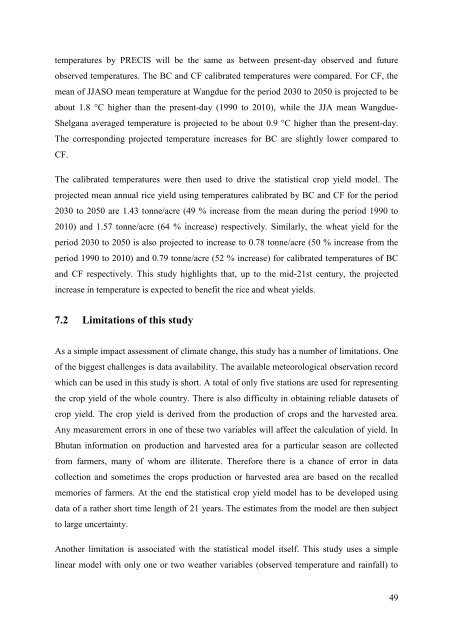UNIVERSITY OF READING - E-Library - WMO
UNIVERSITY OF READING - E-Library - WMO
UNIVERSITY OF READING - E-Library - WMO
You also want an ePaper? Increase the reach of your titles
YUMPU automatically turns print PDFs into web optimized ePapers that Google loves.
temperatures by PRECIS will be the same as between present-day observed and futureobserved temperatures. The BC and CF calibrated temperatures were compared. For CF, themean of JJASO mean temperature at Wangdue for the period 2030 to 2050 is projected to beabout 1.8 °C higher than the present-day (1990 to 2010), while the JJA mean Wangdue-Shelgana averaged temperature is projected to be about 0.9 °C higher than the present-day.The corresponding projected temperature increases for BC are slightly lower compared toCF.The calibrated temperatures were then used to drive the statistical crop yield model. Theprojected mean annual rice yield using temperatures calibrated by BC and CF for the period2030 to 2050 are 1.43 tonne/acre (49 % increase from the mean during the period 1990 to2010) and 1.57 tonne/acre (64 % increase) respectively. Similarly, the wheat yield for theperiod 2030 to 2050 is also projected to increase to 0.78 tonne/acre (50 % increase from theperiod 1990 to 2010) and 0.79 tonne/acre (52 % increase) for calibrated temperatures of BCand CF respectively. This study highlights that, up to the mid-21st century, the projectedincrease in temperature is expected to benefit the rice and wheat yields.7.2 Limitations of this studyAs a simple impact assessment of climate change, this study has a number of limitations. Oneof the biggest challenges is data availability. The available meteorological observation recordwhich can be used in this study is short. A total of only five stations are used for representingthe crop yield of the whole country. There is also difficulty in obtaining reliable datasets ofcrop yield. The crop yield is derived from the production of crops and the harvested area.Any measurement errors in one of these two variables will affect the calculation of yield. InBhutan information on production and harvested area for a particular season are collectedfrom farmers, many of whom are illiterate. Therefore there is a chance of error in datacollection and sometimes the crops production or harvested area are based on the recalledmemories of farmers. At the end the statistical crop yield model has to be developed usingdata of a rather short time length of 21 years. The estimates from the model are then subjectto large uncertainty.Another limitation is associated with the statistical model itself. This study uses a simplelinear model with only one or two weather variables (observed temperature and rainfall) to49
















